This post may contain affiliate links. Please read our disclosure policy.
A silky smooth and luxurious real vanilla custard that can be served hot or cold, alone or with tons of desserts. Plus, this homemade custard recipe requires just five ingredients and a simple process.
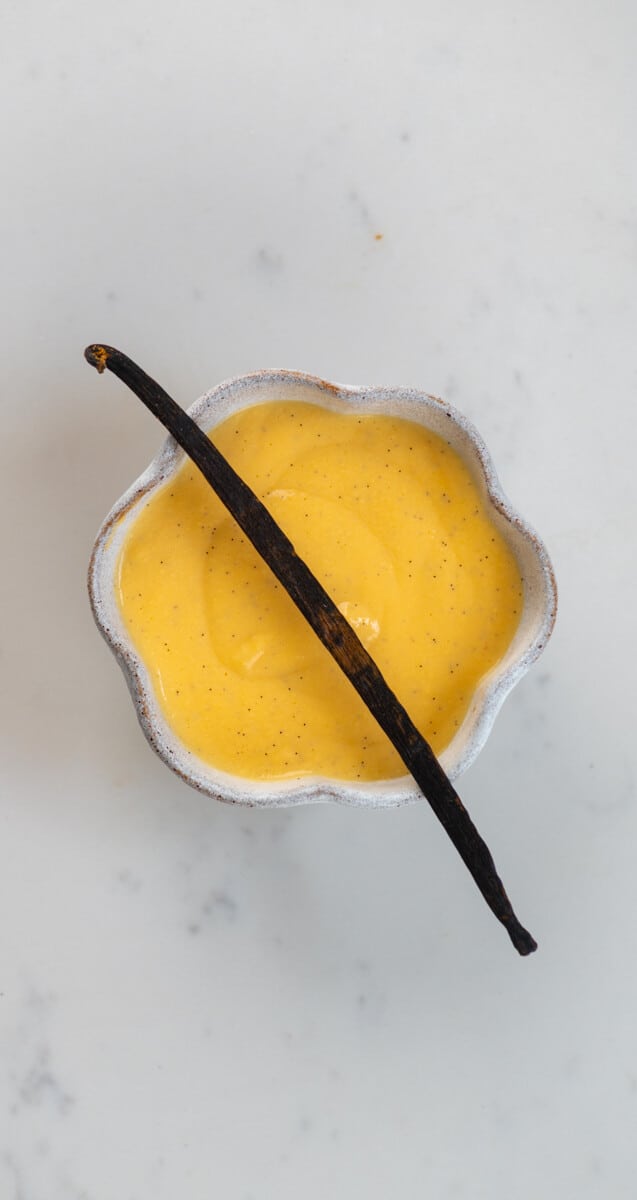
When it comes to dessert time, there is no better accompaniment than silky smooth, vanilla-infused custard. This recipe is flavored with real vanilla beans rather than extract or paste, for a robust, authentic flavor.
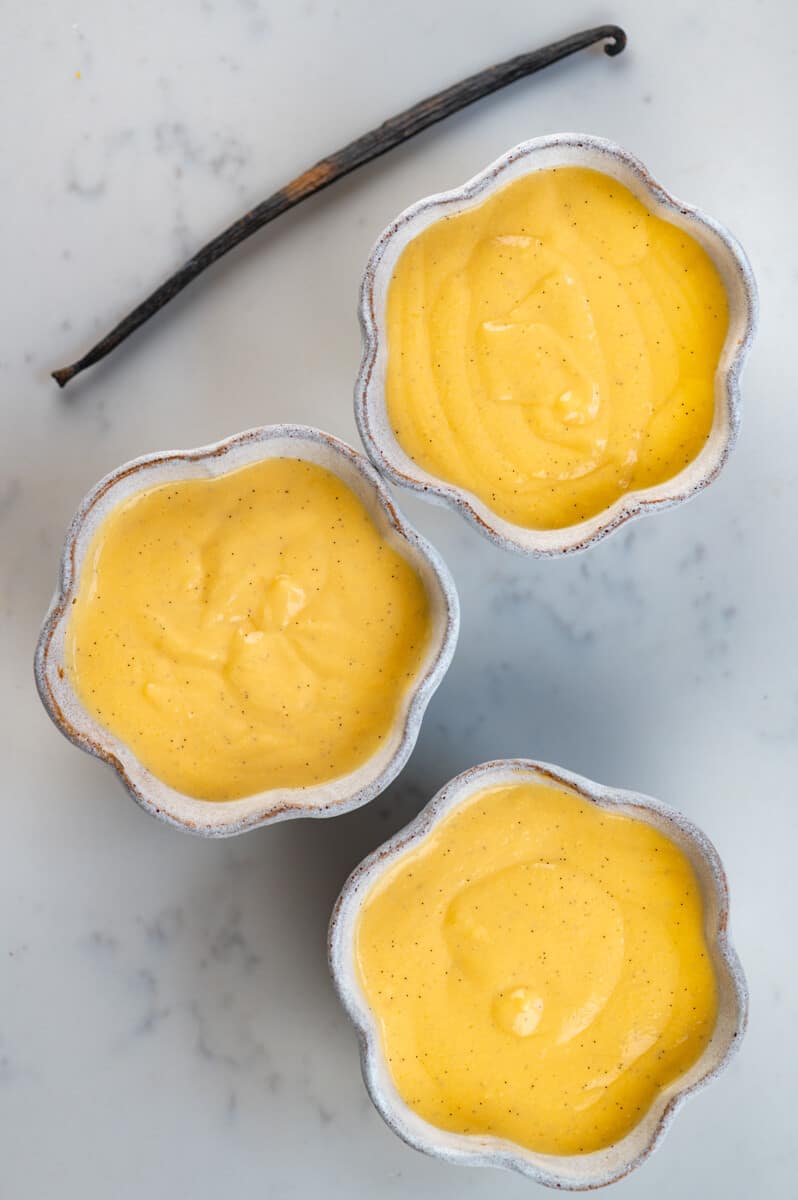
Plus, this traditional egg custard is a pourable consistency (like creme anglaise), to pour over all manner of warm desserts. Perfect for serving with pies, tarts, crumbles, cakes, and more.
Want to save this recipe?
Custard vs Pudding Vs Crème Anglaise
As I was writing this post, it came to my attention that there is some debate over exactly what to name each ‘custard’ product and, thus, this post title.
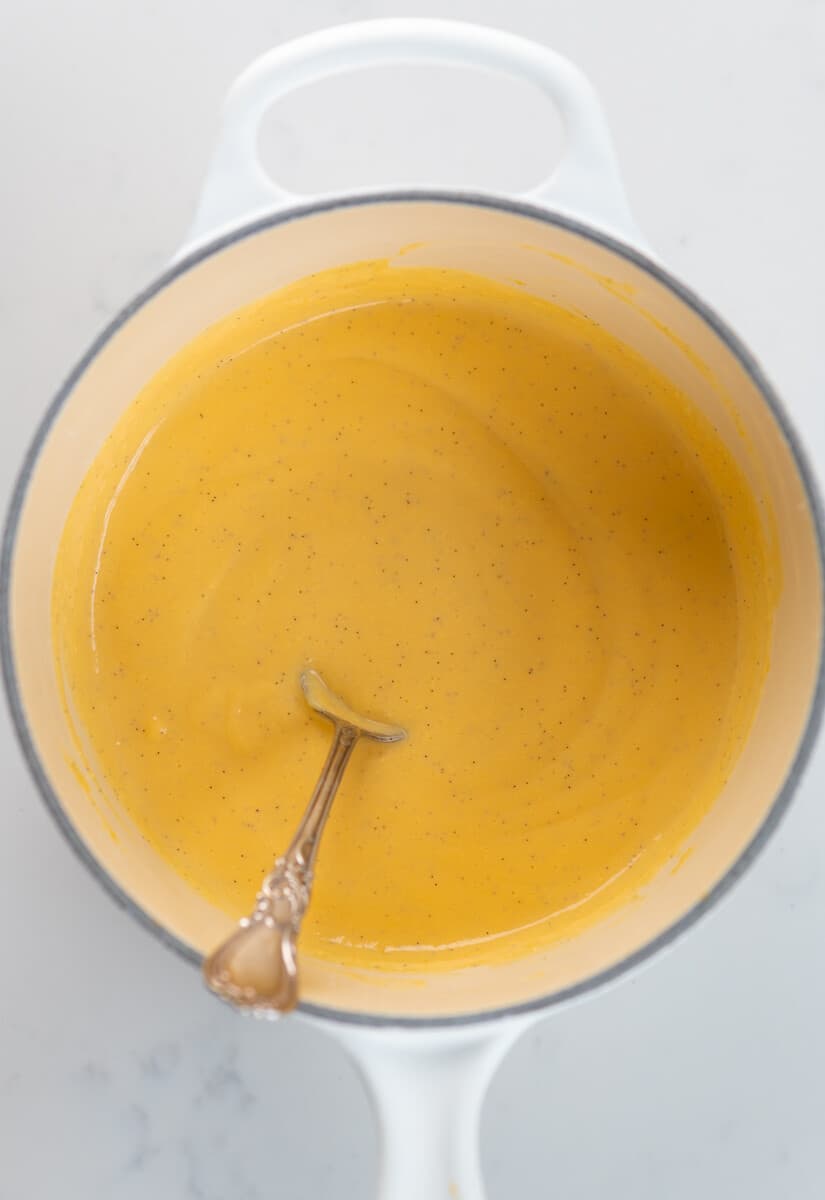
Custard is a fairly generic term for a wide range of products made from milk and/or cream, egg, often vanilla, and sometimes a thickener.
Pudding vs. Custard – Here in the UK, pudding is ‘dessert.’ American pudding is a type of creamy dessert, and custard is a silky-smooth sauce used to pour over desserts or thick enough to add to donuts, etc. The main thing that sets custard apart from ‘pudding’ is the use of egg.
The eggs thicken and provide a delicious consistency not found in your general ‘pudding.’ So, whether you prepare it through stovetop, bain-marie, baked, etc. it’s still referred to as custard.
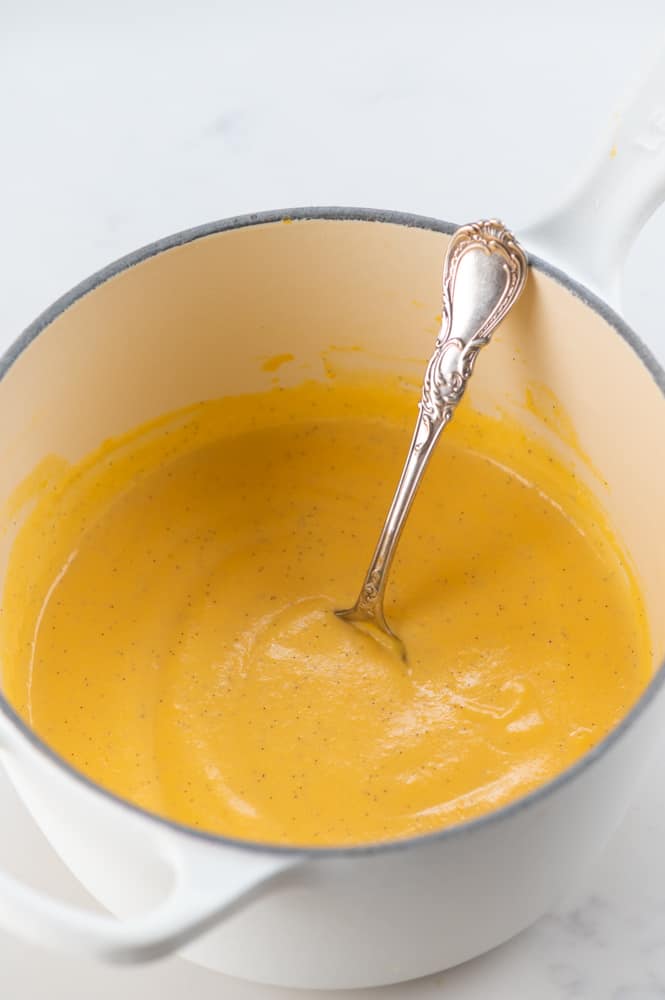
Crème Anglaise (English Cream) is a thin and pourable custard; meanwhile, Crème Pâtissiere (Pastry Cream) is a thick custard used for piping into desserts like cream puffs, eclairs, donuts, etc. And you can, of course, get even firmer custard for desserts like a custard tart, that hold their shape when cut.
Cornstarch or flour is often only used in thicker varieties of custard – though it can be added to pouring custard, too. The starch not only works as a thickener, but it also stabilizes the eggs and prevents them from curdling in the custard. It also helps this process to be done in a single pan rather than a double-boiler or water bath (sous-vide) method.
Without using eggs, the resulting mix with the dairy and thickener would be a blancmange.
In fact, this homemade custard recipe contains both cornstarch and eggs – but is still a pourable ‘custard.’
How to Make Custard
The process for making this recipe is super simple. There are just five ingredients and the only thing you must watch out for is the heat. Cooking the custard over low heat for longer times is crucial as higher heats can cause the eggs to cook into a ‘scrambled egg’ consistency. Instead, it needs to be just thick enough to coat the back of a spoon, before being removed from the heat.
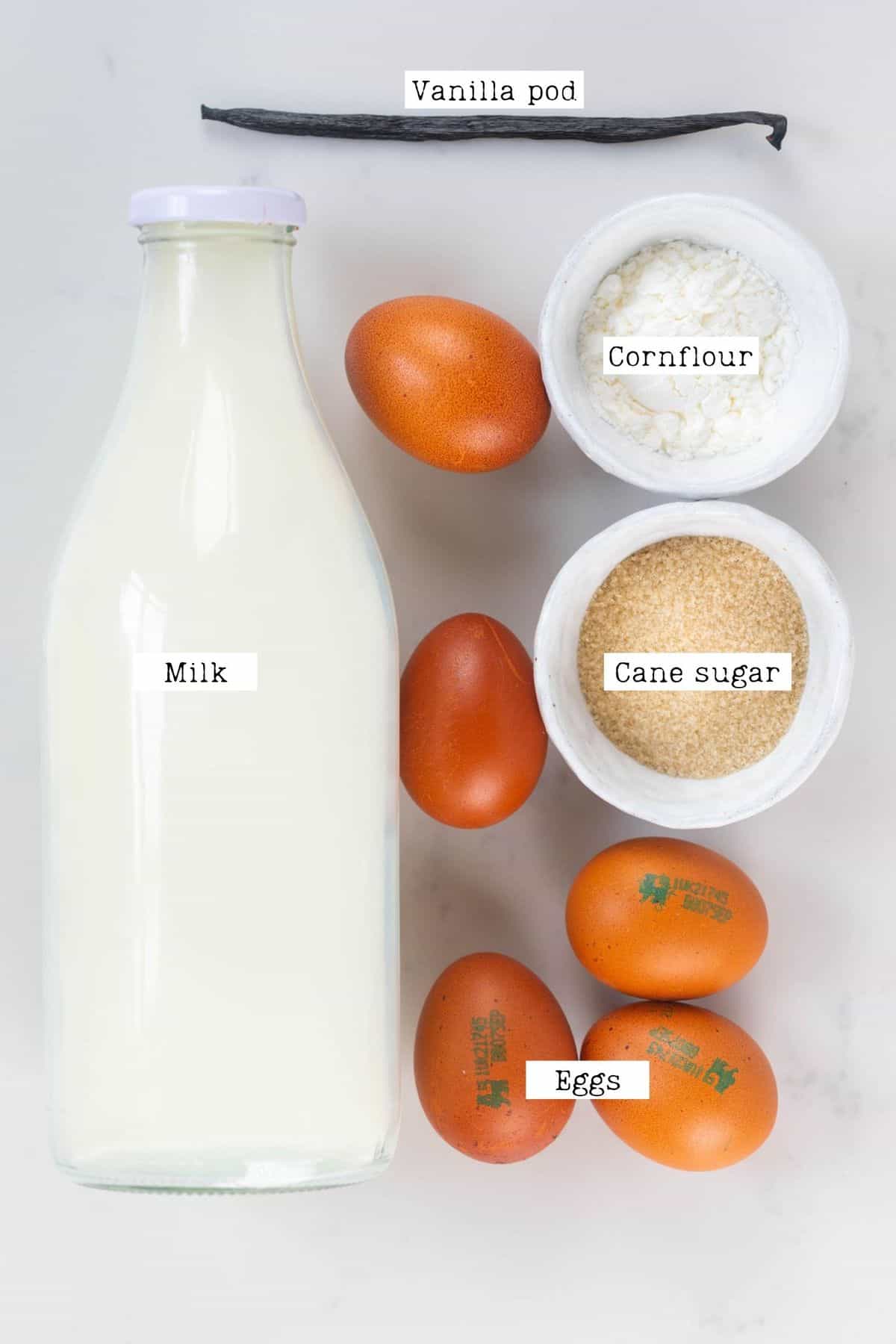
Top Tip: I’ve not included a thermometer in this method, as it doesn’t really need it. However, if you want to be precise, then – cooking temperatures of this custard should never go above 80°C/175°F when not including cornflour. The higher the temperature, the thicker the resulting custard.
Though, because of the addition of starch in this recipe, you can reach slightly higher temperatures without it curdling – especially as cornflour only thickens at 95ºC/203ºF.
The Step By Step Instructions
Begin by adding the milk and vanilla to a pan. Add both the seeds and pod to the milk and then bring to a boil over low-medium heat.
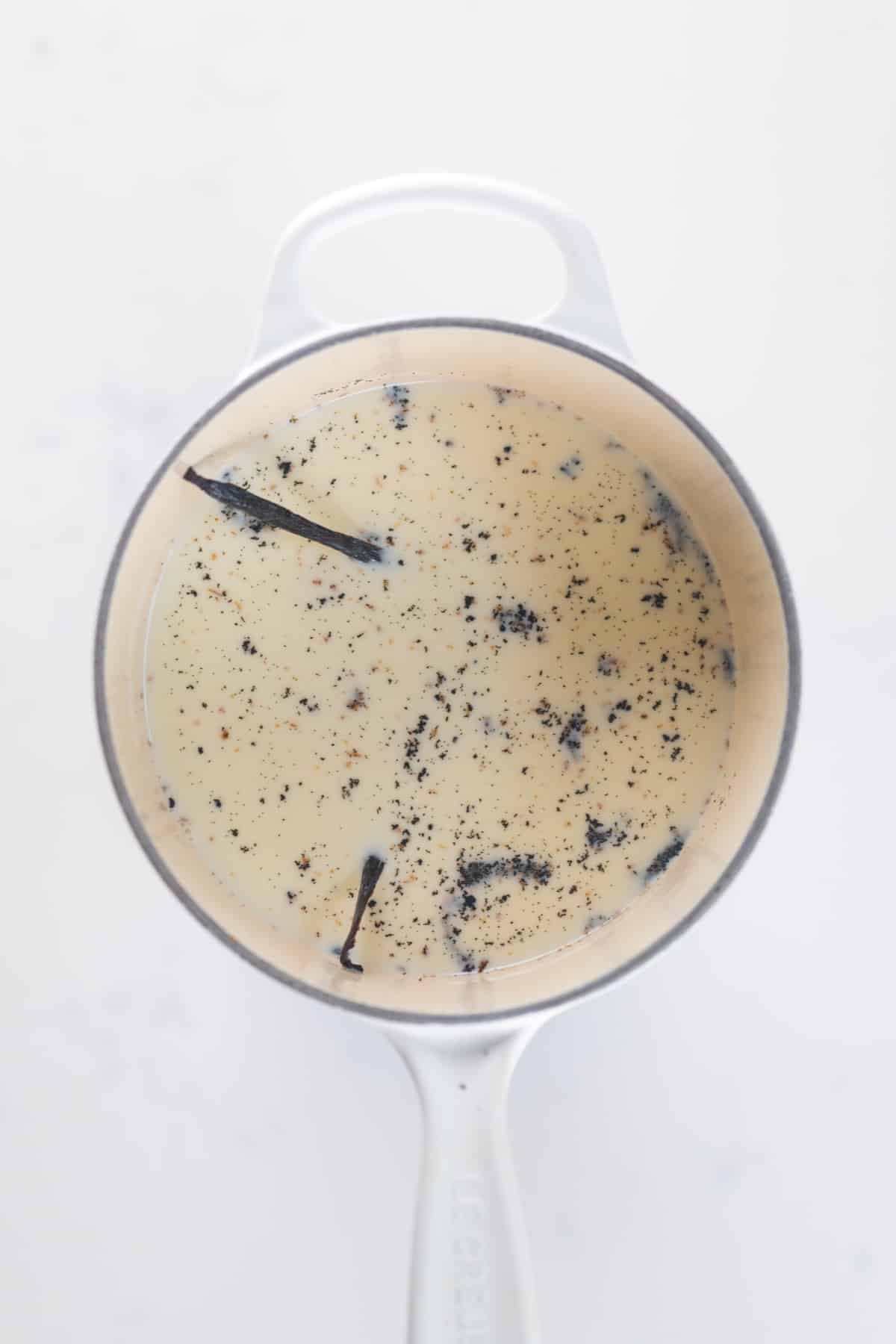
Turn off the heat and remove the vanilla pod from the milk mixture.
Add the egg yolks, sugar, and cornflour to a large bowl and whisk immediately and well, until you have a yellowy cream consistency. This helps prevent the eggs from cooking if you keep the mixture in motion while adding the milk.
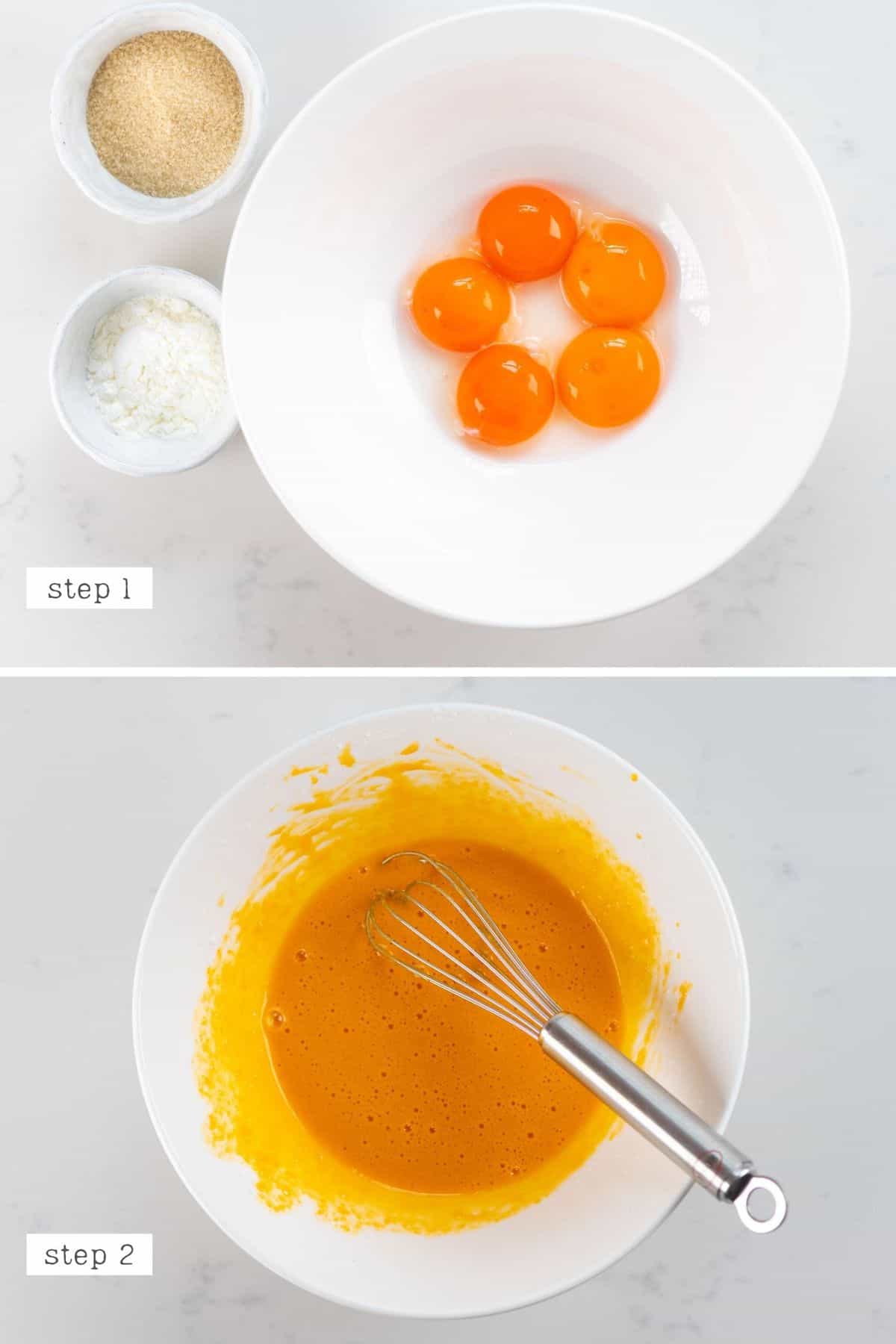
Next, pour the warm milk in slow amounts slowly and gradually into the bowl of egg mixture, whisking well between each addition.
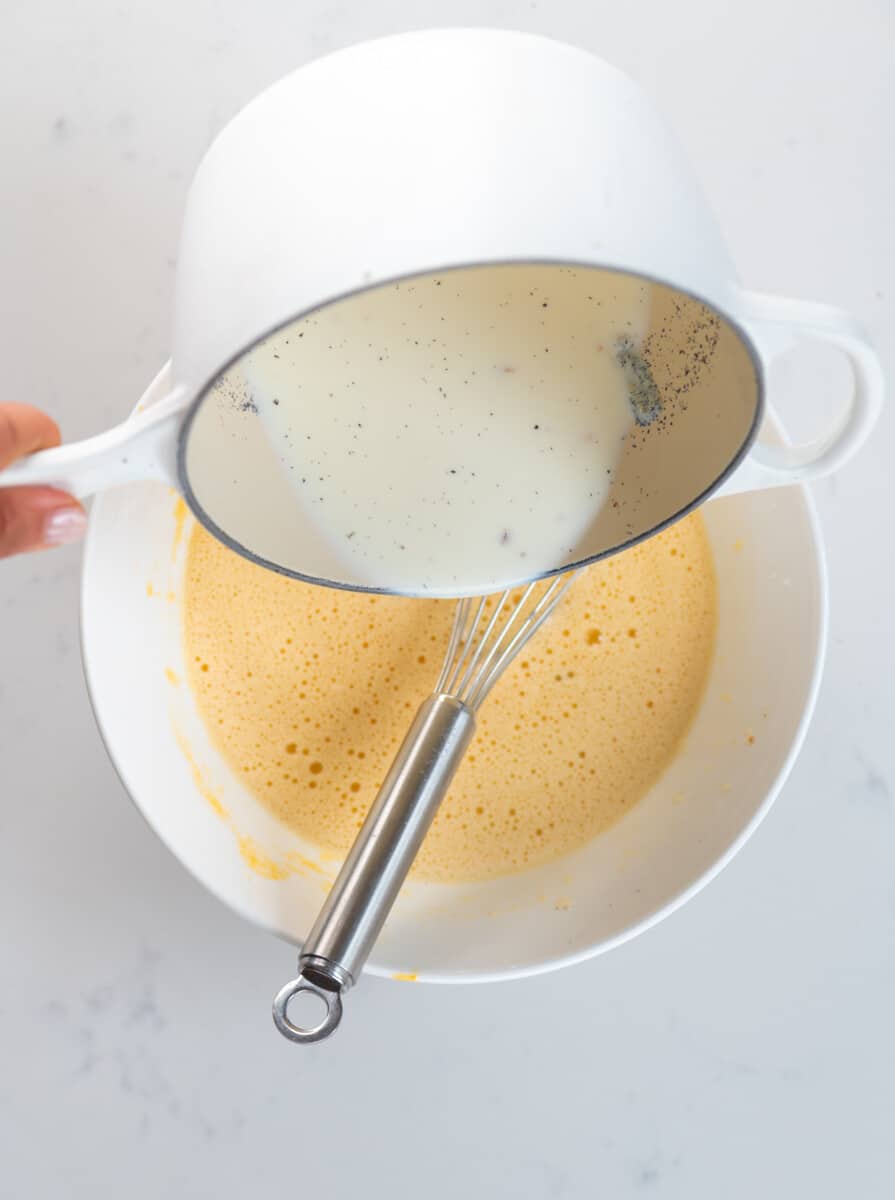
Note* You could also place the egg mixture in a stand mixture and pout in a steady stream of the hot milk while the mixer is on a low speed.
Transfer the mixture back to a pan and heat on low-medium, whisking constantly, until thickened. Depending on how low your heat is, this can take up to 15-20 minutes. Make sure not to boil the mixture at all as this can ruin the custard.
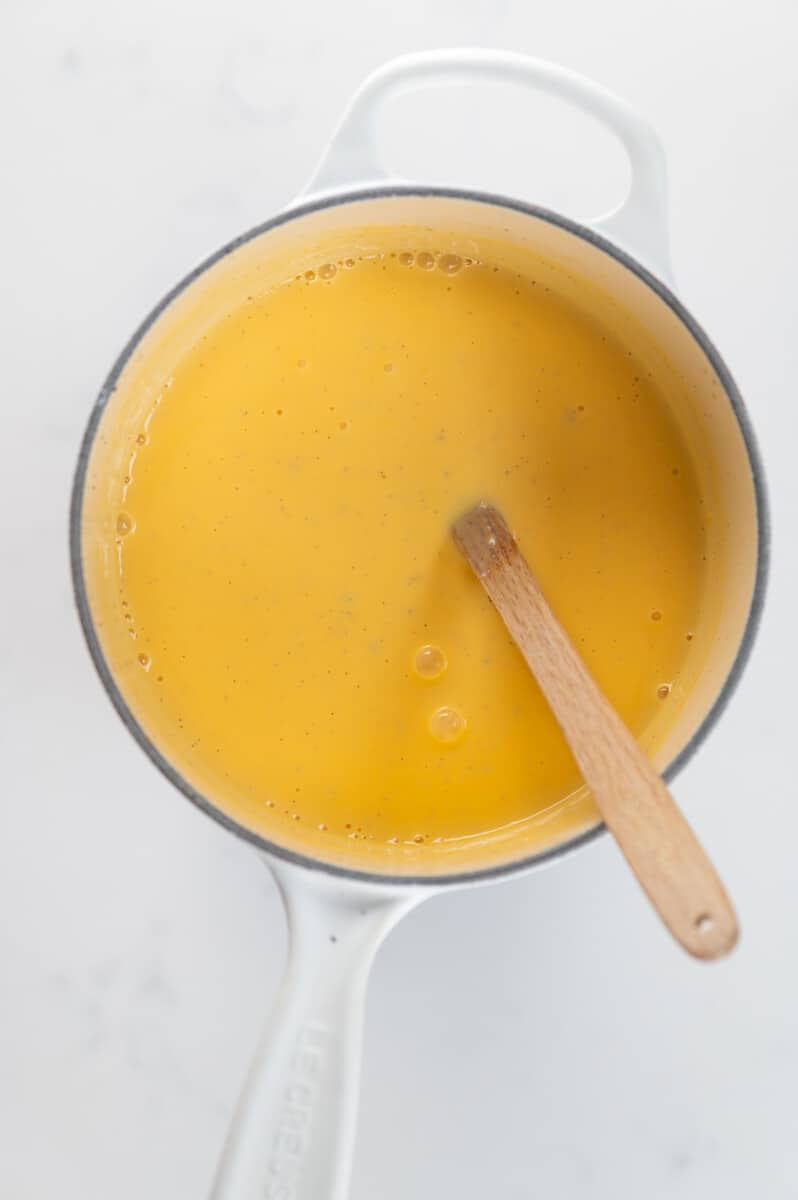
Note* If using a thermometer, then bring the mixture up to 95c/203F, allow to maintain that temperature for around 30 seconds then reduce heat to low and stir until thickened.
Note that the custard will thicken further when cooled.
Optional step: Once ready remove from the heat and add in 1-2tbsp of unsalted butter to the vanilla custard. However, only do this if you don’t want a thicker custard.
You can also, optionally, sieve the custard, for a silky smooth finish.
How to Store:
Serve this vanilla custard immediately while warm or allow it to chill in the fridge until ready to serve, for up to two days.
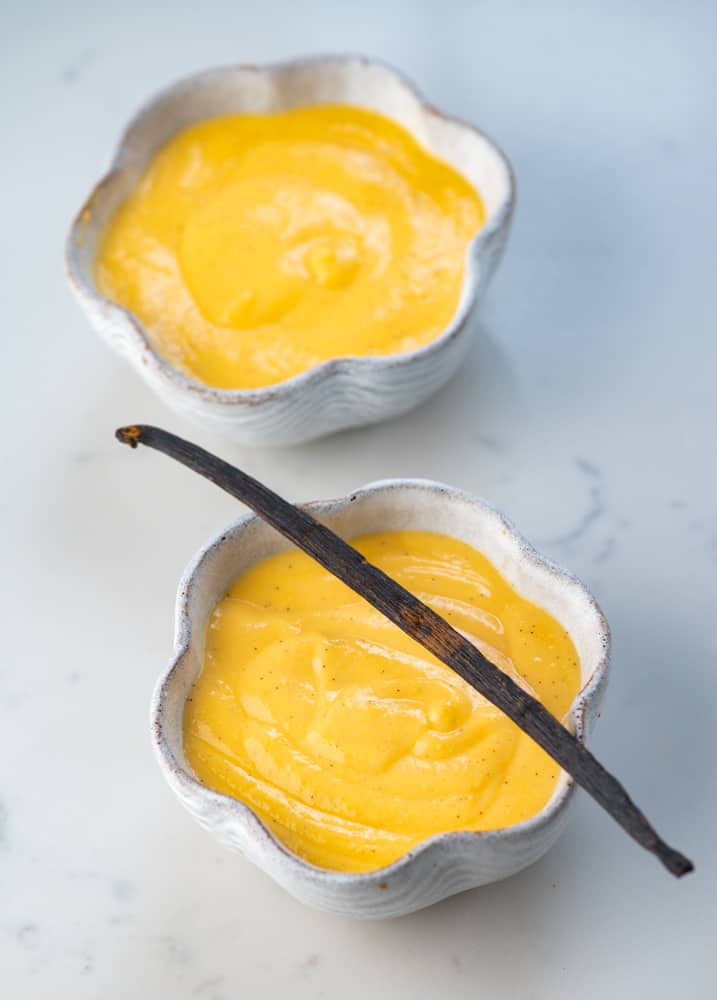
Make sure to cover the top with plastic wrap/beeswax wrap, to prevent a ‘film’ from developing on top of the custard.
How To Keep The Custard Warm:
If you want to serve the homemade custard fairly soon after making it, then you can keep it warm by standing the jug in a pan of hot water, covering the top with plastic wrap (to prevent a skin/film forming).
If you want to keep the custard warm for a few hours, then you can pour it into an insulated flask.
How to Use
You can eat this vanilla custard plain as a ‘pudding,’ bake it into recipes or pour over desserts. The use for the custard really depends on how thick you make it, here are some of my favorite options:
- Use within a trifle
- Bread Pudding
- Pour over fresh fruit
- Over desserts like apple pie, crumble, warm Fudgy Vegan Gluten-Free Chocolate Cake, banana cake.
- Stuff into Donuts and Chocolate Eclairs.
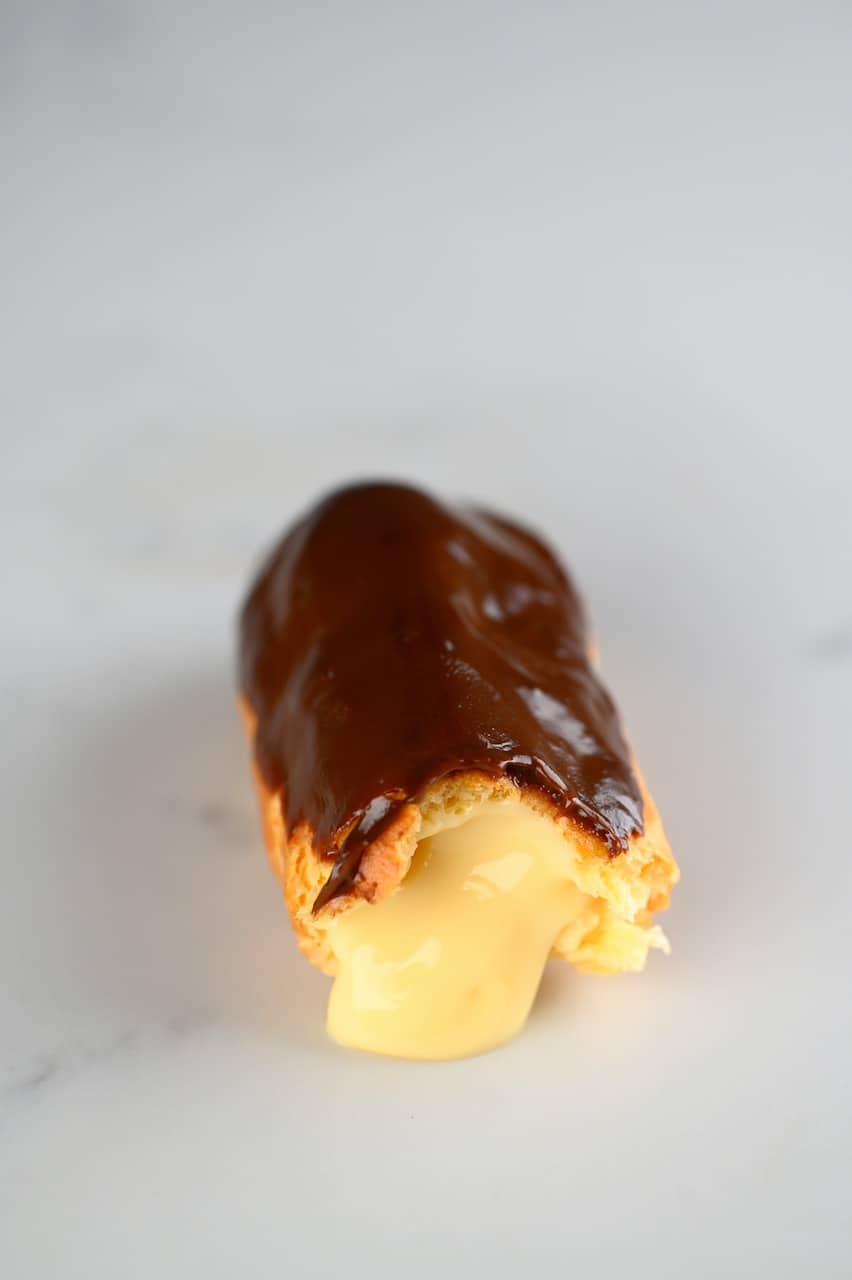
Recipe Notes & Variations
- You can use plain flour in place of cornflour. However, the texture will be more velvety than custard-y.
- For a super-indulgent custard, you can use half milk and half heavy cream in the recipe.
- Feel free to strain the custard through a sieve before serving, to make sure that it’s 100% silky smooth.
- Allowing the custard to boil may cause it to become grainy as it cooks the eggs. Avoid this at all costs. Though, if it does happen, then you can strain the mixture and still use it in many cases.
- There are several ways that you can flavor the custard. Use spices such as cinnamon, cardamom, and nutmeg. Alternatively, you could use extracts like coffee and almond or even alcohol like brandy or bourbon.
- If you find that the custard has become too thick upon setting, then you can beat/whip the mixture lightly before using it. If it’s still warm in the pan, then simply add a little extra milk/cream. I haven’t tried adding extra liquid to beaten/whipped cold custard to know the results.
- Custard is made with raw eggs that are lightly heated. If this is something you’re worried about then you can use pasteurized/heat-treated eggs.
- To turn this into a firmer dessert, then you can pour the custard into individual ramekins within a pan of heated water (bain-marie) and bake until the yolks have set (15-20 minutes).
- You can use vanilla extract or paste if that’s all you have available.
Related Recipes
- Chocolate Pastry Cream (Creme Patissiere)
- Easy Homemade Chocolate Syrup
- Simple Homemade Strawberry Syrup (3 Ways)
- How To Make Homemade Coconut Condensed Milk
- How To Make Coconut Whipped Cream
- Traditional Caramel Ice Cream
If you try this recipe, then let me know your thoughts and any questions in the comments. Also, feel free to tag me in your recreations @AlphaFoodie.
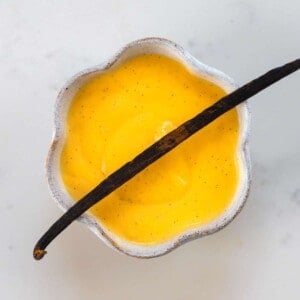
The Ultimate Vanilla Custard
Ingredients
- 2.5 cups whole milk
- 5 egg yolks organic
- 1 vanilla pod
- 2.5 Tbsp raw cane sugar or your favourite sugar
- 1.5 Tbsp cornflour or cornstarch
Instructions
- Begin by adding the milk and vanilla to a pan. Add both the seeds and pod to the milk and then bring to a boil over low-medium heat.
- Turn off the heat and remove the vanilla pod from the milk mixture.
- Add the egg yolks, sugar, and cornflour to a large bowl and whisk immediately and well, until you have a yellowy cream consistency. This helps prevent the eggs from cooking if you keep the mixture in motion while adding the milk.
- Next, pour the warm milk in slow amounts slowly and gradually into the bowl of egg mixture, whisking well between each addition.*
- Transfer the mixture back to a pan and heat on low-medium, whisking constantly, until thickened. Depending on how low your heat is, this can take up to 15-20 minutes. Make sure not to boil the mixture at all as this can ruin the custard.**Note that the custard will thicken further when cooled.You can also, optionally, sieve the custard, for a silky smooth finish.
- Optional step: Once ready remove from the heat and add in 1-2tbsp of unsalted butter to the vanilla custard. However, only do this if you don't want a thicker custard.
How to Store:
- Serve this vanilla custard immediately while warm or allow it to chill in the fridge until ready to serve, for up to two days.Make sure to cover the top with plastic wrap/ beeswax wrap, to prevent a 'film' from developing on top of the custard.
How To Keep The Custard Warm:
- If you want to serve the homemade custard fairly soon after making it, then you can keep it warm by standing the jug in a pan of hot water, covering the top with plastic wrap (to prevent a skin/film forming).If you want to keep the custard warm for a few hours, then you can pour it into an insulated flask.
Video
Notes
- You can use plain flour in place of cornflour. However, the texture will be more velvety than custard-y.
- For a super-indulgent custard, you can use half milk and half heavy cream in the recipe.
- Feel free to strain the custard through a sieve before serving, to make sure that it’s 100% silky smooth.
- Allowing the custard to boil may cause it to become grainy as it cooks the eggs. Avoid this at all costs. Though, if it does happen, then you can strain the mixture and still use it in many cases.
- There are several ways that you can flavor the custard. Use spices such as cinnamon, cardamom, and nutmeg. Alternatively, you could use extracts like coffee and almond or even alcohol like brandy or bourbon.
- If you find that the custard has become too thick upon setting, then you can beat/whip the mixture lightly before using it. If it’s still warm in the pan, then simply add a little extra milk/cream. I haven’t tried adding extra liquid to beaten/whipped cold custard to know the results.
- Custard is made with raw eggs that are lightly heated. If this is something you’re worried about then you can use pasteurized/heat-treated eggs.
- To turn this into a firmer dessert, then you can pour the custard into individual ramekins within a pan of heated water (bain-marie) and bake until the yolks have set (15-20 minutes).
- You can use vanilla extract or paste if that’s all you have available.
Nutrition
Nutrition information is automatically calculated, so should only be used as an approximation.

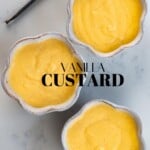
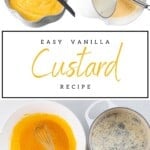
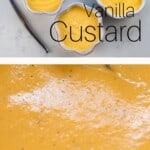
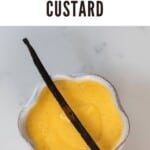
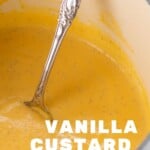










I love this recipe but I can’t seem to get a silky smooth consistency. I’ve tried it twice so far. I make sure not to boil my custard and milk, just get them nice and hot. The first time I whisked my eggs and sugar until just combined, and the second time I whisked them until their were a pale yellow consistency. I also make sure to very very slowly stream in my milk while whisking. Still it feels a bit grainy when it’s finished! Any advice?
Hi Lylah,
I’m sorry you are having a hard time with the custard. You can try to strain the custard through a sieve to get it silky smooth. I hope this helps.
I made macarons yesterday and needed to use up the five egg yolks I had left. This not only was a gorgeous and delicious custard but a perfect match for my yolks! This recipe will now be a go to recipe!
Thank you so much for your comment, Emily! I am happy you enjoyed the recipe!
Excellent recipe, smooth divine and velvety. I would call creme anglaise. Super delicious
Thank you so much for your comment 🙂
What does the optional Tbsp of butter do?
Hi Leigh,
It thins the custard a bit. Skip if you want a thicker custard.